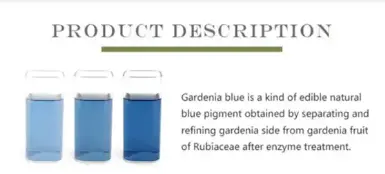Gardenia Blue Powder, derived from the fruit of the Gardenia jasminoides plant, is a natural blue food coloring agent that has gained popularity in recent years. As with any food product, understanding its shelf life is crucial for both manufacturers and consumers. The shelf life of Gardenia Blue Powder can vary depending on several factors, including storage conditions, packaging, and manufacturing processes. Generally, when stored properly, Gardenia Blue Powder can maintain its quality and effectiveness for an extended period.

How does storage temperature affect the longevity of Gardenia Blue Powder?
The storage temperature plays a significant role in determining the shelf life of Gardenia Blue Powder. Like many natural food colorants, Gardenia Blue Powder is sensitive to temperature fluctuations and extreme heat. Optimal storage conditions can help preserve its vibrant blue hue and coloring properties for a longer duration.
To maximize the shelf life of Gardenia Blue Powder, it's recommended to store it in a cool, dry place away from direct sunlight. Ideally, the storage temperature should be maintained between 15°C to 25°C (59°F to 77°F). Avoiding exposure to high temperatures is crucial, as heat can accelerate the degradation of the pigments responsible for the blue color.
Refrigeration can further extend the shelf life of Gardenia Blue Powder. When stored in a refrigerator at temperatures between 2°C to 8°C (36°F to 46°F), the powder can maintain its quality for an even longer period. However, it's essential to protect the powder from moisture when refrigerating, as condensation can lead to clumping and potentially affect its performance.
On the other hand, freezing is not recommended for Gardenia Blue Powder. Extreme cold temperatures can cause structural changes in the powder, potentially altering its coloring properties when thawed. Additionally, the freeze-thaw cycle can introduce moisture into the product, leading to clumping and reduced effectiveness.
It's worth noting that temperature fluctuations can be detrimental to the stability of Gardenia Blue Powder. Consistent storage conditions are key to maintaining its quality over time. If the powder is exposed to varying temperatures during transportation or storage, it may experience a shortened shelf life or reduced coloring efficacy.
What packaging methods can extend the shelf life of Gardenia Blue Powder?
The packaging of Gardenia Blue Powder plays a crucial role in preserving its quality and extending its shelf life. Proper packaging protects the powder from external factors that could compromise its integrity, such as moisture, light, and air exposure.
Airtight containers are essential for storing Gardenia Blue Powder. These containers prevent the absorption of moisture from the air, which can cause the powder to clump and potentially degrade. Glass or high-quality plastic containers with tight-fitting lids are ideal choices. Some manufacturers use special moisture-resistant packaging materials to further protect the product.
Light-resistant packaging is another important consideration. Exposure to light, especially UV rays, can cause the degradation of the natural pigments in Gardenia Blue Powder. Amber or opaque containers can help shield the powder from light, preserving its color and potency. Some companies use dark-colored or metalized packaging materials to provide additional protection against light exposure.
Vacuum-sealed packaging is an effective method to extend the shelf life of Gardenia Blue Powder. By removing air from the package, this technique minimizes oxidation and moisture absorption, two factors that can significantly impact the powder's longevity. Vacuum-sealed pouches or containers can help maintain the powder's freshness for an extended period.
Individual serving packets or sachets can also be beneficial, especially for consumers who use the powder infrequently. These single-use packages reduce the exposure of the bulk product to air and moisture each time it's opened, potentially extending the overall shelf life of the product.
It's important to note that once the original packaging is opened, the shelf life of Gardenia Blue Powder may be reduced. To maximize longevity after opening, transfer the powder to an airtight, light-resistant container if the original packaging doesn't provide adequate protection. Always ensure that utensils used to scoop the powder are clean and dry to prevent introducing moisture or contaminants.
Can the manufacturing process influence the shelf life of Gardenia Blue Powder?
The manufacturing process of Gardenia Blue Powder can significantly impact its shelf life. Various factors during production can affect the stability and longevity of the final product, including extraction methods, purification processes, and quality control measures.
The extraction method used to obtain the blue pigment from Gardenia fruits is crucial. Traditional methods involve steeping the fruits in water or alcohol, but more advanced techniques such as ultrasonic-assisted extraction or supercritical fluid extraction can yield purer and more stable pigments. These advanced methods can potentially result in a Gardenia Blue Powder with a longer shelf life due to fewer impurities and better color stability.
Purification processes play a vital role in removing unwanted compounds that could accelerate degradation. Techniques such as column chromatography or membrane filtration can help isolate the desired blue pigments, reducing the presence of substances that might compromise the powder's stability over time. A more purified product generally has a longer shelf life and better color retention properties.
The drying process is another critical step that can affect shelf life. Spray drying is commonly used in the production of Gardenia Blue Powder, as it allows for rapid drying at relatively low temperatures, helping to preserve the integrity of the pigments. Some manufacturers may use freeze-drying techniques, which can result in a powder with excellent stability and a potentially longer shelf life due to the gentle nature of the process.
Quality control measures implemented during manufacturing can also influence shelf life. Strict controls on temperature, humidity, and hygiene throughout the production process can minimize the risk of contamination and ensure a more stable final product. Additionally, standardization of the pigment concentration in each batch can lead to more consistent performance and predictable shelf life across different production runs.
Some manufacturers incorporate natural stabilizers or antioxidants into their Gardenia Blue Powder formulations. These additives can help protect the pigments from degradation caused by oxidation or exposure to light, potentially extending the product's shelf life without compromising its natural status.
It's worth noting that ongoing research in food science and technology continues to improve manufacturing processes for natural food colorants like Gardenia Blue Powder. Innovations in encapsulation technologies, for example, may lead to future products with even greater stability and longer shelf lives.
Conclusion
In conclusion, the shelf life of Gardenia Blue Powder is influenced by a combination of factors including storage temperature, packaging methods, and manufacturing processes. By maintaining optimal storage conditions, using appropriate packaging, and employing advanced manufacturing techniques, the shelf life of Gardenia Blue Powder can be significantly extended. As consumer demand for natural food colorants continues to grow, ongoing research and development in this field are likely to yield further improvements in the stability and longevity of products like Gardenia Blue Powder.
If you are also interested in this product and want to know more product details, or want to know about other related products, please feel free to contact lea_slsbio@163.com,WhatsApp+86 13193326505.

References
1. Chu, J., et al. (2018). "Gardenia Blue Colorants: Chemistry, Stability, and Applications in Food." Comprehensive Reviews in Food Science and Food Safety, 17(5), 1208-1226.
2. Wang, L., et al. (2019). "Extraction, purification and application of natural blue colorant from Gardenia jasminoides Ellis." Food Chemistry, 275, 390-398.
3. Zhang, X., et al. (2020). "Recent advances in the stability and application of Gardenia blue pigment." Trends in Food Science & Technology, 96, 145-154.
4. Li, Y., et al. (2017). "Stability of natural blue colorant from Gardenia jasminoides Ellis under different pH, temperature and light conditions." International Journal of Food Properties, 20(sup3), S2805-S2817.
5. Yusuf, M., et al. (2017). "Natural Colorants: Historical, Processing and Sustainable Prospects." Natural Products and Bioprospecting, 7(1), 123-145.
6. Sigurdson, G. T., et al. (2017). "Natural Colorants: Food Colorants from Natural Sources." Annual Review of Food Science and Technology, 8, 261-280.

